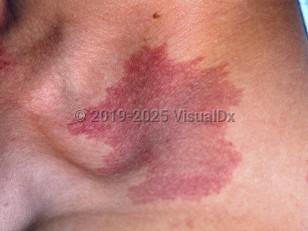Port-wine stain in Child
See also in: External and Internal EyeAlerts and Notices
Important News & Links
Synopsis

A port-wine stain (also termed nevus flammeus) is a type of vascular malformation known as a capillary malformation. In the past, port-wine stains and salmon patches were considered to be variations of capillary malformation; it is now known that port-wine stains are truly malformations of capillaries that may be associated with systemic complications and will never spontaneously improve. Furthermore, salmon patches represent dilatation of capillaries rather than a true malformation. These often fade with time if located on the face and are not associated with any other abnormalities.
Port-wine stains are typically congenital. Some port-wine stains darken over time, especially if located on the lower face. They may also become thicker and more nodular, and can develop pyogenic granulomas within them. This usually occurs in early adulthood.
When a port-wine stain occurs on the forehead, Sturge-Weber syndrome (SWS) should be considered. SWS can include eye abnormalities (choroidal vascular anomalies, buphthalmos, and glaucoma) and leptomeningeal and brain abnormalities.
Port-wine stains on the lower back that cross the midline may be associated with dimples, sinuses, lipomas, faun-tail deformities (see lumbosacral skin lesion), and, most importantly, tethered cord. In these locations, neurological consultation and ultrasound or MRI is indicated.
Klippel-Trenaunay syndrome (angio-osteohypertrophy) consists of a triad of vascular stain, hemihypertrophy, and venous varicosities. In the past, the vascular stain has been thought to be a pure capillary malformation; however, it is now recognized that it is more commonly a combined capillary, lymphatic, and/or venous malformation. Some specialists prefer to characterize this syndrome with a description of the specific malformations found in each patient.
Phakomatosis pigmentovascularis is characterized by the coexistence of a capillary malformation and a cutaneous pigmented lesion. Both are typically present at birth.
Port-wine stains are typically congenital. Some port-wine stains darken over time, especially if located on the lower face. They may also become thicker and more nodular, and can develop pyogenic granulomas within them. This usually occurs in early adulthood.
When a port-wine stain occurs on the forehead, Sturge-Weber syndrome (SWS) should be considered. SWS can include eye abnormalities (choroidal vascular anomalies, buphthalmos, and glaucoma) and leptomeningeal and brain abnormalities.
Port-wine stains on the lower back that cross the midline may be associated with dimples, sinuses, lipomas, faun-tail deformities (see lumbosacral skin lesion), and, most importantly, tethered cord. In these locations, neurological consultation and ultrasound or MRI is indicated.
Klippel-Trenaunay syndrome (angio-osteohypertrophy) consists of a triad of vascular stain, hemihypertrophy, and venous varicosities. In the past, the vascular stain has been thought to be a pure capillary malformation; however, it is now recognized that it is more commonly a combined capillary, lymphatic, and/or venous malformation. Some specialists prefer to characterize this syndrome with a description of the specific malformations found in each patient.
Phakomatosis pigmentovascularis is characterized by the coexistence of a capillary malformation and a cutaneous pigmented lesion. Both are typically present at birth.
Codes
ICD10CM:
Q82.5 – Congenital non-neoplastic nevus
SNOMEDCT:
416377005 – Port-wine stain of skin
Q82.5 – Congenital non-neoplastic nevus
SNOMEDCT:
416377005 – Port-wine stain of skin
Look For
Subscription Required
Diagnostic Pearls
Subscription Required
Differential Diagnosis & Pitfalls

To perform a comparison, select diagnoses from the classic differential
Subscription Required
Best Tests
Subscription Required
Management Pearls
Subscription Required
Therapy
Subscription Required
References
Subscription Required
Last Reviewed:11/16/2017
Last Updated:12/03/2017
Last Updated:12/03/2017
 Patient Information for Port-wine stain in Child
Patient Information for Port-wine stain in Child
Premium Feature
VisualDx Patient Handouts
Available in the Elite package
- Improve treatment compliance
- Reduce after-hours questions
- Increase patient engagement and satisfaction
- Written in clear, easy-to-understand language. No confusing jargon.
- Available in English and Spanish
- Print out or email directly to your patient
Upgrade Today

Port-wine stain in Child
See also in: External and Internal Eye
